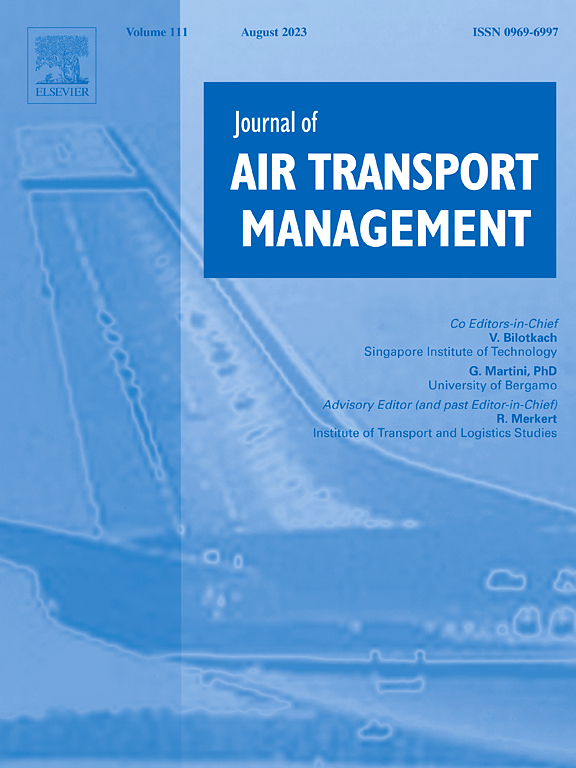Optimizing air traffic management through point merge procedures: Minimizing delays and environmental impact in arrival operations
IF 3.6
2区 工程技术
Q2 TRANSPORTATION
引用次数: 0
Abstract
We present an application of a mixed-integer programming (MIP) framework for automatic traffic synchronization, providing safe separation between the arriving traffic within the terminal maneuvering area (TMA) of an airport implementing point merge (PM) procedures. Additionally, the proposed methodology ensures conflict-free operations when departures and arrivals share a common runway. Based on real traffic scenarios for two European airports, we model realistic descent profiles and assume all the arrivals are performing the most fuel-efficient continuous descent operations (CDOs). We compare two scenarios: in the first, the arriving aircraft are strictly forced to adhere to the published arrival route structures, meaning that a turn towards the merge point may not be initiated prior to reaching the point merge system (PMS), while in the second scenario, aircraft may be assigned a shortcut from a published waypoint along the arrival route. We evaluate the resulting arrival flight efficiency and compare it to that of the actual flights, arriving during the hour selected for our optimization, noticing varying benefits for the two airports and whether shortcuts are allowed or not. Given the correct setting for the specific airport, we demonstrate that our approach provides significant benefits, including increased vertical performance as well as reduced time and distance, contributing to lower levels of noise and fuel savings, accompanied by reduced emissions.
通过点合并程序优化空中交通管理:尽量减少到达时的延误和对环境的影响
我们提出了一个混合整数规划(MIP)框架的应用,用于自动交通同步,在机场终端机动区域(TMA)内提供安全的到达交通分离,实现点合并(PM)程序。此外,拟议的方法确保在离港和抵港共用一条跑道时的无冲突行动。基于两个欧洲机场的真实交通场景,我们模拟了真实的下降曲线,并假设所有到达的飞机都在执行最省油的连续下降操作(cdo)。我们比较了两种情况:在第一种情况下,到达的飞机被严格强制遵守发布的到达路线结构,这意味着在到达点合并系统(PMS)之前可能不会启动向合并点的转弯,而在第二种情况下,飞机可能会从发布的航路点沿着到达路线分配一条捷径。我们评估了最终的到达航班效率,并将其与实际航班的效率进行比较,在我们选择的优化时间内到达,注意到两个机场的不同效益以及是否允许走捷径。在特定机场的正确设置下,我们证明了我们的方法提供了显著的好处,包括提高垂直性能,缩短时间和距离,有助于降低噪音和节省燃料,同时减少排放。
本文章由计算机程序翻译,如有差异,请以英文原文为准。
求助全文
约1分钟内获得全文
求助全文
来源期刊

Journal of Air Transport Management
TRANSPORTATION-
CiteScore
12.40
自引率
11.70%
发文量
97
期刊介绍:
The Journal of Air Transport Management (JATM) sets out to address, through high quality research articles and authoritative commentary, the major economic, management and policy issues facing the air transport industry today. It offers practitioners and academics an international and dynamic forum for analysis and discussion of these issues, linking research and practice and stimulating interaction between the two. The refereed papers in the journal cover all the major sectors of the industry (airlines, airports, air traffic management) as well as related areas such as tourism management and logistics. Papers are blind reviewed, normally by two referees, chosen for their specialist knowledge. The journal provides independent, original and rigorous analysis in the areas of: • Policy, regulation and law • Strategy • Operations • Marketing • Economics and finance • Sustainability
 求助内容:
求助内容: 应助结果提醒方式:
应助结果提醒方式:


